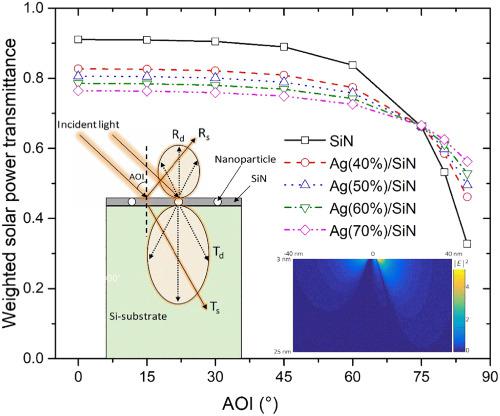当前位置:
X-MOL 学术
›
Prog. Photovoltaics
›
论文详情
Our official English website, www.x-mol.net, welcomes your feedback! (Note: you will need to create a separate account there.)
Wide angle antireflection in metal nanoparticles embedded in a dielectric matrix for plasmonic solar cells
Progress in Photovoltaics ( IF 6.7 ) Pub Date : 2020-02-22 , DOI: 10.1002/pip.3258 Bhaskar Singh 1 , Mohammed M. Shabat 2 , Daniel M. Schaadt 1
Progress in Photovoltaics ( IF 6.7 ) Pub Date : 2020-02-22 , DOI: 10.1002/pip.3258 Bhaskar Singh 1 , Mohammed M. Shabat 2 , Daniel M. Schaadt 1
Affiliation

|
The photon density in solar cells is usually optimized through tailored antireflection coatings (ARCs). We develop an analytical model to describe metal hybrid nanoparticles (NPs)‐based ARC, where metal NPs are embedded in a standard ARC on a Si‐substrate. A point dipole approach is implemented to calculate diffuse reflectance by NPs, while transfer matrix method is used for specular reflectance from front surface. We found that embedding metal NPs in SiN ARC enhances the antireflection property of the former at non‐normal angles of incidence (AOI) of light. Electric field distribution patterns of radiation in the substrate by NPs are calculated for various AOI, which support the improvements in the antireflection property. Weighted solar power transmittances from ARCs are calculated, which show that Ag‐NPs (radius = 35 nm) embedded in SiN (thickness = 70 nm) performs better than SiN for AOI over 74°, whereas Al‐NPs (radius = 35 nm) embedded in SiN (thickness = 70 nm) performs better for AOI over 78°.
中文翻译:

嵌入等离子太阳能电池介电基质中的金属纳米粒子的广角抗反射
通常通过定制的抗反射涂层(ARC)来优化太阳能电池中的光子密度。我们开发了一个分析模型来描述基于金属杂化纳米颗粒(NPs)的ARC,其中金属NP嵌入在Si基板上的标准ARC中。实现了点偶极子方法来计算NP的漫反射率,而传递矩阵法则用于从正面反射镜面反射率。我们发现,将金属NPs嵌入SiN ARC中可以增强前者在非垂直入射角(AOI)时的抗反射性能。针对各种AOI,计算了由NP引起的基板中辐射的电场分布图,这支持抗反射性能的提高。计算来自ARC的加权太阳能透射率,
更新日期:2020-02-22
中文翻译:

嵌入等离子太阳能电池介电基质中的金属纳米粒子的广角抗反射
通常通过定制的抗反射涂层(ARC)来优化太阳能电池中的光子密度。我们开发了一个分析模型来描述基于金属杂化纳米颗粒(NPs)的ARC,其中金属NP嵌入在Si基板上的标准ARC中。实现了点偶极子方法来计算NP的漫反射率,而传递矩阵法则用于从正面反射镜面反射率。我们发现,将金属NPs嵌入SiN ARC中可以增强前者在非垂直入射角(AOI)时的抗反射性能。针对各种AOI,计算了由NP引起的基板中辐射的电场分布图,这支持抗反射性能的提高。计算来自ARC的加权太阳能透射率,



























 京公网安备 11010802027423号
京公网安备 11010802027423号